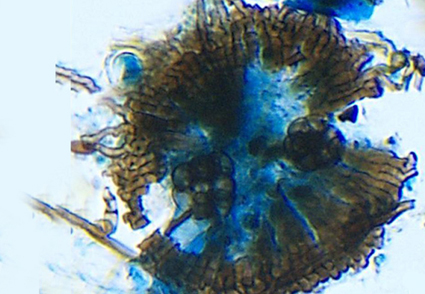Abstract
Asterinaceous black mildews are ectophytic, obligate biotrophs that live on many flowering plants, shrubs, and trees. Five new species were found in forests in the south western part of Maharashtra state. Two of these species produce sexual spores and are described in the genus Asterina. Two asexually reproducing species are described in Asterostomella and a third species in Asterostomula. All species are illustrated by photographs and line drawings.
References
- Arx, J.A. & Muller, E. (1975) A re-evaluation of the bitunicate ascomycetes with keys to families and genera. Studies in Mycology 9: 1–159.
- Bhise, M.R., Patil, C.R., Salunkhe, C.B. & Kambhar, S.V. (2021) New species of Asterina and Balladyna (black mildew fungi) from Mahabaleshwar, Maharashtra, India. Phytotaxa 511 (3): 283–288. https://doi.org/10.11646/phytotaxa.511.3.7
- Bhise, M.R., Patil, C.R., Salunkhe, C.B. & Kambhar, S.V. (2023) Asterina macrosolenae sp. nov. (Asterinales, Asterinaceae) from northern Western Ghats, India. Journal of Mycopathological Research 61 (1): 127–129. https://doi.org/10.57023/JMycR.61.1.2023.125
- Bilgrami, K.S., Jamaluddin, S. & Rizwi, M.A. (1991) Fungi of India. List and References. Today and Tomorrow’s Printers & Publishers, New Delhi.
- Hansford, C.G. (1956) Tropical fungi—VI. New species and revisions. Sydowia 10: 41–100.
- Hofmann, T.A. (2009) Plant parasitic Asterinaceae and Microthyriaceae from the Neotropics (Panama). Ph.D. Thesis. The faculty of biological sciences at the J. W. Goethe-University Frankfurt am Main, Germany, 408 pp.
- Hosagoudar, V.B. (2003) Asterinaceae of India. Zoos´ Print Journal 18: 1280–1285. https://doi.org/10.11609/JoTT.ZPJ.18.12.1280-5
- Hosagoudar, V.B. (2010) Anamorphs of Asterinales. Journal of Theoretical and Experimental Biology 6: 199–211.
- Hosagoudar, V.B. (2012) Asterinales of India. Mycosphere 2: 617–852. https://doi.org/10.5943/mycosphere/3/5/9
- Hosagoudar, V.B. & Abraham, T.K. (2001) A list of Asterina Lev. species based on literature. Journal of Economic and Taxonomic Botany 24: 557–587.
- Patil, C.R. & Patil, S.C. (2017) A mounting and permanent slide preparation technique for Cryptogams. Bioscience Discovery 8 (1): 6–8.
- Singh, N.P., Lakshminarasimhan, P., Karthikeyan, S. & Prasanna, P.V. (2000) Flora of Maharashtra State. Dicotyledones, Vol. I & II. Botanical Survey of India, Calcutta.


